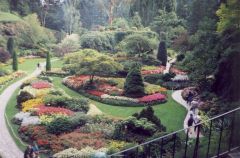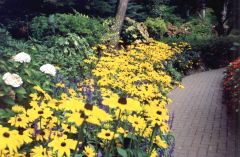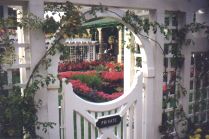September 1998
<<<
Tuesday, 1 - Tuesday, 8 September
1998
What a lazy week it’s been. The weather continued to be perfect, warm with
cloudless skies all day long. We ventured out several times to the nearby
seaside town of White Rock, which true to its
name has a huge white (painted) rock on the beach. It is a picturesque town,
with a long promenade along the seafront, a pier and numerous flower-covered
restaurants overlooking the sea. Valerie was pleased to find that Canada has
many English-style tea rooms, some of which we had to check out. It was
Valerie’s birthday on the 1st which provided yet another opportunity to try out
one of the better local restaurants. Valerie will have to wait for the majority
of her birthday cards as we have not called off our mail recently, however she
managed to buy two new outfits to compensate.
George continued to make the most of the Internet hook-up and the US Open tennis
competition on TV kept Valerie entertained. The VHS ham radio has been
disappointing throughout Canada and Alaska, with hardly any radioactivity other
than near a few large towns. Also, hopes of using the system as a means of
sending Emails have disappeared since few areas in North America offer a phone
patch facility for travellers. A big plus has been the acoustic coupler working
with every Canadian pay phone we used, this compares to about 7 out of 10 phones
in the US.
|
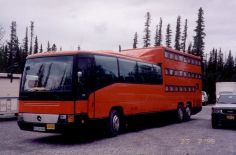
|
|
At several campgrounds, we have come across one
of the huge German camper coaches which enable
up to 25 to camp in comfort. The front of the
bus has normal touring coach seating, while the
rear has individual sleeping cubicles. The group
travel together for two to three weeks so by the
end of their tour they must be very well
acquainted!
|
|
Log houses are very popular in the north which
is not surprising considering the vastness of
the Canadian forests and the huge lumber
industry. Valerie would love one of these log
houses since as well as looking good, most are
situated in beautiful countryside settings. Of
late the Canadian dollar has continued to fall
against most of the major currencies, which at
the current rate of 2.5 dollars to the pound,
makes Canada a very attractive place to visit.
|
Wednesday, 9 September 1998
After a very relaxing 12 days, it was time to move on. We caught the noon ferry
from Tsawwassen to
Swartz Bay, which lies at the southern end of
Vancouver Island. The crossing took nearly two hours. Compared to the
English Channel the C$152 (62 pounds) was a very good value, bearing in mind
that we are 55 feet long. It was a pleasant crossing, part of which was past
tree-covered islands. Surprisingly upon landing the traffic was very busy,
through winding roads but as usual, Valerie had no trouble finding the
campground. We found we were camped next to a couple from Switzerland who had
purchased a 34-foot Holiday Rambler motor home and had been touring for about
one and a half years. The husband had suffered a stroke while in Mexico but
refused to go home as he was enjoying every moment. We frequently eat out but
normally do not make any comments in our travelogue since it would get
repetitious. However, today’s meal was of note, as we found close to the
campground an English-style pub with a lot of character. Established in 1858,
the gardens in The Four Mile Pub were a mass of flowers, so we ate what turned
out to be an excellent meal, outside under a flower-laden pergola.
Thursday, 10 September 1998
|
We spent the day in
Victoria which is the capital of
British Columbia,
which lies at the southern end of Vancouver
Island. Masses of flower baskets adorn every
lamppost, which supports the city's claim to be
the flower basket capital of the world. Together
with large areas of flower beds, it was a
pleasure to walk around the inner harbour area.
|
|
After taking in the sights of the grand
buildings surrounding the harbour and then a
walk through the very impressive Empress Hotel,
it was off to the museum. This has excellent
displays of natural history and local Indian
artefacts. After a good lunch in a mock Charles
Dickens pub, we then took a bus tour of
downtown. The city and surrounding region are
major retirement locations for the rich.
Oak Bay is the
place to live with numerous upmarket homes,
several expensive golf courses as well as
hundreds of sailing boats in the harbour. The
whole area has a very British atmosphere,
typified by the weekly cricket match stopping
for tea at 4.00 p.m.
|
|

|
Friday, 11 September 1998
|
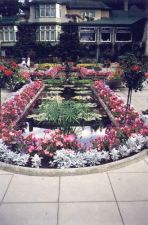
|
|
During the morning Valerie was intent on buying
clothing but ended up with a new handbag. The
main event of the day was our late afternoon
visit to The
Butchart Gardens which were remarkable.
The gardens have been brilliantly laid out in an
old worked-out limestone quarry. In particular,
the sunken garden is magnificent, which suddenly
comes into view after passing through what
initially appears to be a narrow passage going
nowhere. We stayed on until after dark since the
gardens are illuminated. We particularly enjoyed
the Ross Fountain which with its colourful
lights and misty clouds at the base, has an air
of mystery and beauty. We finished the day by
driving into the centre of Victoria to
view the illuminations on the Government
Building but spent more time along with hundreds
of other tourists watching the buskers
performing along the water's edge.
|
|
|
|
|
Saturday, 12 September 1998
Today’s main event was provided by a mouse who has decided to live in our RV.
Valerie has several times seen a black shape move across dark parts of the RV
and was convinced it was a huge spider. However this evening the mouse must have
been hungry since it decided to make several dashes while we were watching TV.
It has now disappeared and Valerie refuses to go to bed until George catches it.
It could be a long night! Earlier today we move camp to
Parksville which is some 80 miles north of Victoria along
Vancouver Island’s east coast. On route, we were only able to obtain
occasional glimpses of the coastline and a few of the distant islands but it
sure looked good.
Sunday, 13 September 1998
Vancouver Island
is about 250 miles long, averages 55 miles wide and is mainly covered by
mountains about 5,000 feet high. George wanted to see something of the island's
western coast which is somewhat rugged and is only accessible by one road. On
route, several huge lakes caught our attention, partly as they were very
picturesque but mainly because of the solitude and lack of any development. Upon
arrival at the coast, dense sea fog blanketed the beach for much of the time but
in some ways, it added to the charm. After walking for some distance along the
sandy Long Beach which lies within the
Pacific Rim National Park, we
drove on to the Tofino peninsular. It is difficult
to see the beach or sea along most of the coastal roads due to the dense
tree-lined rugged terrain, which is a shame since it is a very attractive
coastline. The small town of Tofino lies in a beautiful location,
surrounded by numerous islands with views of successive mountain ranges in the
distance. We watched seaplanes, boats and kayaks, which were coming and going
all the time, this type of activity seems to typify the Canadian outdoor
lifestyle.
Monday, 14 September 1998
Our unwelcome visitor will not be travelling with us when we leave tomorrow,
having succumbed to a strategically placed piece of chocolate! After local
shopping, laundry, cleaning and some reading, the day seemed to be over in no
time.
Tuesday, 15 September 1998
The weather is still perfect, apparently better than normal but is due to cool
down later this month, so time to head further south. We caught the 3.00 p.m.
ferry from Victoria to Port Angeles
which lies on the north coast of Washington,
close to the Olympic Mountains. The
one-and-a-half-hour crossing was calm and some porpoises and seals made an
appearance, as well as millions of small fish, which thousands of seagulls were
enjoying. The US immigration formalities were completed as we boarded the ferry
in Canada, where our request for a four months stay was to be granted six
months, which is tempting! Customs clearance was carried out upon landing in the
US, which was no more than a "where do you live"? to which Valerie, who was
driving the car behind, replied - with him!
Wednesday, 16 September 1998
The entrance to the Olympic National Park
lies just to the south of our campground, so with another brilliant sunny
morning, we drove into the park and up about 6,000 feet to the
Hurricane Ridge Visitors Centre. After
coffee, we hiked for some distance through some beautiful mountain terrain with
the snow-covered Mount Olympus in the
distance. It was so quiet that our footsteps seemed to disturb the peace.
Nothing seemed to be moving other than an occasional cricket jumping out of our
way. The mountains rise steeply along the western coastline, intercepting the
moisture-rich air masses from the Pacific. Some 200 inches of rain a year falls
in the west, producing rainforests. However 30 miles to the east on the other
side of the mountains, less than 17 inches of rain falls.
To the east of our campground is the aptly named
Dungeness National Wildlife refuge. The terrain is very similar to its
namesake in England being a somewhat flat and desolate area, with a long narrow
spit of land extending into the sea. Being America, it claims to be the world's
longest natural sand spit. It is some five miles long and we have to admit more
attractive than Kent’s offering. We walked some way along the water's edge where
we saw harbour seals and a few sea birds. The area must have major storms since
the whole coastline is littered with driftwood. In this case, the driftwood is
complete trees, typically 50 feet long and up to five feet in diameter. Most
look attractive as they have been bleached white by the sun and would make an
ideal focal point in a large garden.
Thursday, 17 September 1998
The majority of the Washington coastline seems to be highly indented,
with numerous inlets, islands and lakes. The terrain is so confusing that at
times it is difficult to know if one is looking at a large lake or the sea. In
places, the sea can be on both sides of the road at the same time and then
further on it disappears. It is all very attractive so we moved just 40 miles to
the east to make it easier to see more of the
Olympic Peninsula, camping at the SKP park at
Chimacum.
Friday, 18 - Saturday, 19 September 1998
The local seaside town of Port Townsend is
one of the oldest cities in the state, having numerous examples of Victorian
architecture, complete with turrets and is designated a National Historic
Landmark. Perhaps the most unusual of the town's attractions is the Tree of
Heaven, reputedly a gift from a Chinese emperor in the 1860s. Today the town is
more famous for making wooden boats and has just held its annual wooden boat
regatta. After a delicious fish and chips lunch, we strolled around the
waterfront shops and watched the ferry leaving for yet another of the many
islands around the coast. It is an interesting town but not worth a detour.
Sunday, 20 September 1998
We needed to be in Yakima by Wednesday where the car
is booked in for repair so we headed further south. After 150 miles we felt we
had gone far enough for the day, so we stopped at
Silver Creek where we camped facing a large lake. Campgrounds vary
enormously and this one sets itself apart with its wide variety of mature trees
which provide pleasant privacy for some of the campsites. Outside the camp
office, life-size bronze statues surround a large pond full of goldfish. At
night flaming torches held by the statues add further to the atmosphere.
Monday, 21 September 1998
A quiet day partly spent enjoying the perfect weather and partly obtaining
medication for George, who has developed an infection. If nothing else it
allowed us to have a closer look at the American health system. The visit to the
local medical centre first involved temperature, blood pressure, weight and
specimen checks, followed by a long series of questions from the assistant. The
consultation with the doctor lasted about 15 minutes, culminating in a
discussion about the cost of the various treatment options. Did George want the
cheap but maybe less effective drug or the very much more expensive but better
drug? Maybe it’s the way things back home may go.
Tuesday, 22 September 1998
To cross over the Rocky Mountains we
ascended the White Pass which peaks at 4,500
feet. On route, we had several good views of the huge snow-covered
Mount Rainier. Even though today was warm and
sunny, within a few weeks the pass could be closed due to heavy snowfalls. The
descent followed the fast-flowing Tieton River
for about twenty miles. It’s a whitewater river where several groups were
getting very wet running the rapids in rubber rafts. Once through the mountains,
the terrain was parched and brown but irrigation in the valley enables vast
areas of fruit trees to be successfully grown. Our campground in Yakima
is very disappointing, particularly when we compare it to the peaceful and quiet
we have just left. Today’s campground has small sites, most of which are
occupied by long-stay tenants, which in our opinion always changes the
atmosphere for the worse. However, we have little choice, since it is the best
available while we get the car repaired, which is scheduled to take all day
tomorrow.
Wednesday, 23 September 1998
Indeed, as Valerie predicted the car repair is going to take longer than a day.
The main job to replace the engine oil seal was completed by mid-afternoon.
However, when repairing the ABS it was found that a previous repair had not been
carried out correctly and critical parts are missing. As usual, the required
parts are not in stock and would not be available until Friday. The only
consolation is that we can use the car tomorrow. so at least we can do some
shopping and maybe a little local sightseeing.
Thursday, 24 September 1998
Apples are big business in Washington. Washington produces 60% of
the apples consumed in the USA, as well as exporting around the world, including
the UK. We are in the middle of a huge fruit-growing area and the apple-picking
season is just getting underway. Masses of wooden boxes line the edge of
orchards, which will soon be filled mainly by Mexican labour who come north for
the season. Nearby is the Fruit Growers Visitor Centre where we had a closer
look at the industry. Somewhat surprising was how quickly apples are gathered,
sorted and placed into cold storage, where they can remain for up to a year.
Friday, 25 September 1998
|
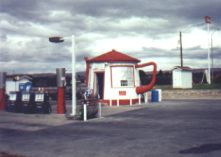
|
|
At 11.00 a.m. George took the car in to have the
missing parts fitted. As the work only took 40
minutes, we were soon heading along Route 82
towards the Tri-Cities.
On route through Zillah,
we passed a gas station in the shape of a
teapot, which was done very well. Half an hour
later we were into heavy rain which is the first
serious rain we have had in some time. We camped
near Richland
which is one of the Tri-Cities, the
others being Pasco
and Kennewick,
all located near the confluence of the huge
Columbia river
and renowned Snake
river.
|
Saturday, 26 September 1998
A few weeks ago Kevin upstaged his Dad by having a video link for the family Net
conference. Not to be outdone and to aid in editing the 20 or so camcorder video
tapes we have so far taken, it was off to the shops to buy a Studio 400 editor.
Having found one on offer, the rest of the day was given over to George playing
with his latest toy.
Sunday, 27 September 1998
At virtually every campground we find that most people are friendly and want to
pass the time of day. in particular, if our fellow campers are Escapee members.
Most SKPs are full-timers, many have retired and sold their house to give them
the freedom to travel without care or material ties. Our SKP neighbour recently
retired from the US airforce at the age of 50 and is now travelling full time
running a business selling phone hook-ups to campground owners. This made George
prick up his ears as it could mean the dreaded acoustic coupler could be
consigned to the trash can. However, hopes were dashed when told that the device
will not available until next year! Mid-morning we moved on to
Pendleton some 80 miles east along Interstate 82,
which for the most part was almost empty.
Monday, 28 September 1998
We spent some hours at the
Tamastslikt Cultural Institute where we were reminded of the poor way
the indigenous Indian population were treated by the white man, as the west was
conquered during the mid-eighteenth century. Time and again wars were started by
the white man, as he forcibly took lands which had been assigned to the Indians
by treaty. The Indians also suffered badly from white man diseases, to which
they had no natural immunity. The display cleverly takes one on a journey from
early history and mythology through to the way the Indians would like to see
their future development. Interestingly many of their old stories and fables are
based on the coyote. They regard it as a clever animal, from which they have
learnt a lot. The Institute is splendidly located in a complex consisting of a
championship golf course, RV park, hotel resort and casino, where Valerie could
not resist the urge and squandered $5 on the slots.
Tuesday, 29 September 1998
Yet another brilliantly clear, sunny morning, which always makes it easier to
get George out for his early morning walk. After breakfast, an hour or more was
spent downloading lots of messages and files. Only a few campgrounds provide a
phone hook-up, this one is free and is located in the laundry meaning that an
outlet is also available to power the computer. Our 130-mile route today was
over the Blue Mountain foothills, however,
being autumn they are a parched brown. Talk about the ultimate in tow vehicles,
en route we were overtaken by an RV towing a helicopter, the driver/pilot will
never have to worry about traffic jams again! At La
Grande, we turned north where for thirty or so miles the terrain
is lush farmland due to extensive irrigation. We climbed through attractive
mountains and then followed a river through deep canyons. Our destination was
just beyond the town of Joseph and the large
attractive Wallowa Lake. Shortly after
settling in, several deer munched their way around the RV, before moving down to
the river.
Wednesday, 30 September 1998
The Indian summer continues and today was yet another day without any clouds
throughout the day. We had to smile when the weather channel announced that it
was snowing in Alaska, which it seems we only left a short while ago. Our
campground is at the base of towering mountains, which are part of the
10,000-foot Wallowa Mountain range. The
5,700-foot-deep Hells Canyon lies to the
north, which is deeper than the Grand Canyon. For good reason, the area is
called The Switzerland of America. We came here almost by chance, since we just
picked up the map, put our finger on a place and said let us go there. As it
turned out the local town of Joseph, named after the famous Chief of the
Nez Perce Indians, is a major bronze casting centre. It is a small town with few
shops but most seem to be selling art objects, in particular the most beautiful
bronze statues.
The morning was spent at the Valley Bronze
Gallery where they have the most impressive range of bronze statues.
After watching a video showing the numerous steps involved during the
manufacturing process, we were off to the factory to watch the process for real.
We were amazed at how many steps are involved, so explaining why bronze statues
are expensive. It is called the "Lost Wax" process, which starts with the
artist’s completed sculpture, usually made in clay, wax or wood. The next step
must give the artist a heart attack since the completed masterpiece is cut into
pieces, so silicon rubber moulds can be made. The rubber mould is then coated in
plaster, cut in half, and filled with wax, the wax replica is coated in slurry,
and put into a furnace where the wax runs out, so leaving a cavity in the now
rock-hard slurry, into which the bronze is poured. The various bronze parts are
then welded together, join marks removed and finally coloured by a process
called patina. During the factory tour, we saw hundreds of beautiful statues,
most of which are made in limited edition. The statues ranged from delicate
figurines to a massive fifteen-foot-high, two-ton bull.
>>>
Home



